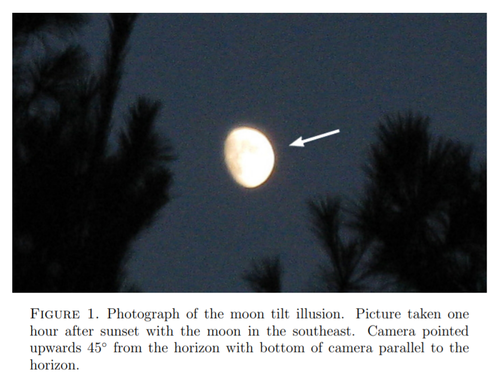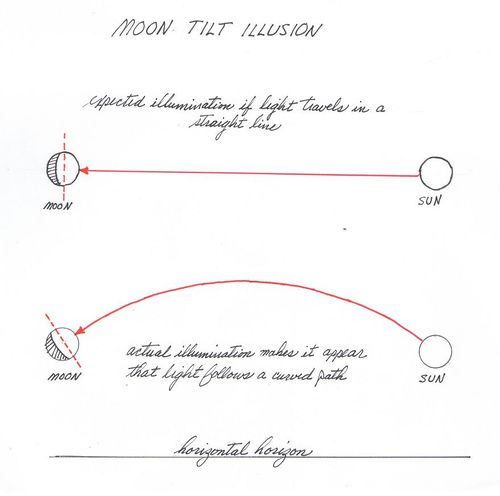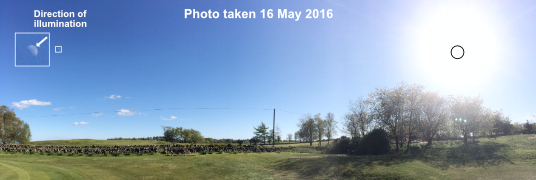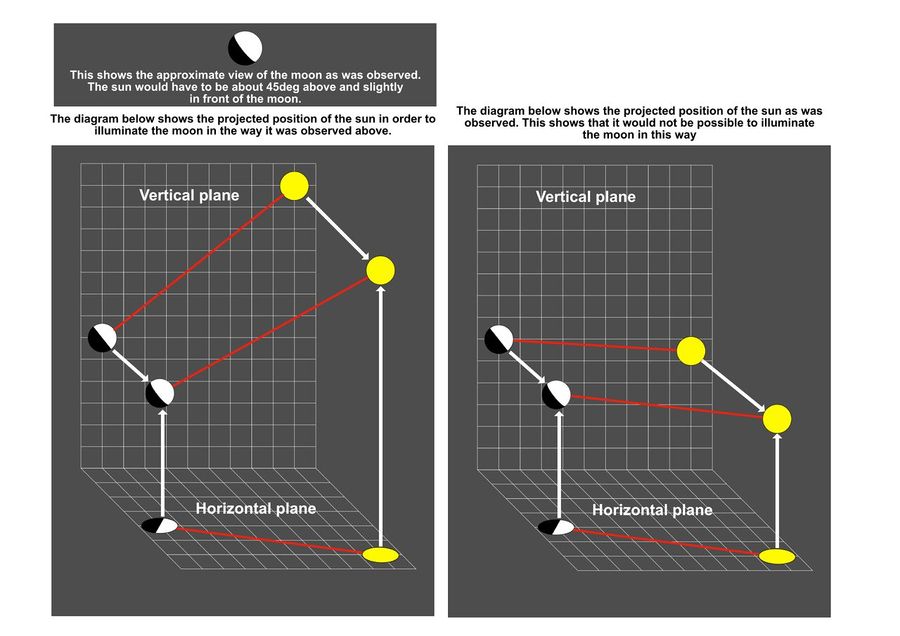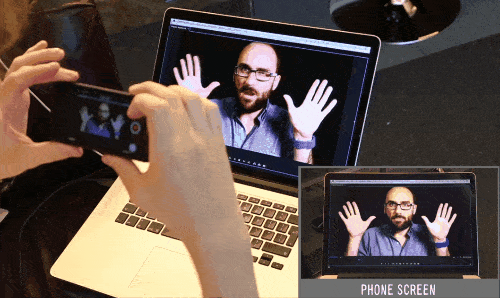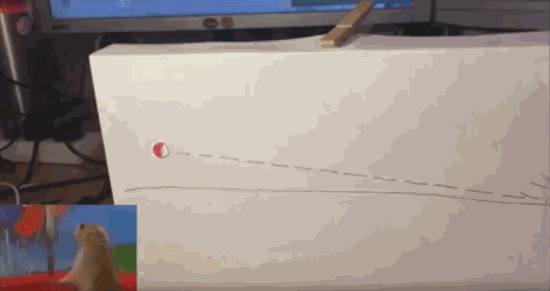Moon Tilt Illusion
Description
Professor Myers at the University of Pennsylvania provides the following description:
http://www.upenn.edu/emeritus/essays/MyersMoon.html (Archive)
“ One evening several years ago, I took this picture of the misty glow of an almost full moon shining between pine trees in my backyard. The moon was beautifully illuminated and dominated the dark sky. Yet something was disturbing about the atmospheric night scene: the illumination of the moon seemed to be coming from the wrong direction! In this photograph of a waxing moon in the southern sky, its illumination appears to be coming from above to the right. But the sun---which had set an hour earlier---was already below the western horizon to the right when this photo was taken. If the sun is below the horizon, I thought, shouldn't its illumination of the moon appear to be coming from below the horizon? Intrigued, I made further observations when both the sun and the moon occupied the evening sky at the same time, and it certainly seemed that light rays from the sun would have to follow a curved path to shine on the moon at the observed angle. The sketch drawn below may help to explain the difference between what I expected to see and what I actually saw.
I asked everyone willing to listen if they were familiar with this illusion: why does a light ray from the sun to the moon appear to follow a curved path? No one had seen or heard of it. Several imaginative explanations were offered: "The light rays are bent by the earth's atmosphere." Or, "Gravitational lensing as predicted by Einstein's general theory of relativity is responsible." I was surprised not to find the illusion described in astronomy textbooks. I googled "moon illusion" but the articles were about an entirely different illusion: the apparent magnification of the full moon when it's close to the horizon.
Finally, help came from my daughter, who located published papers by googling "moon tilt illusion". The scientific explanation is based on the projection of a straight line onto the surface of a sphere. A simpler explanation was provided in a conversation with Benjamin Shen, Professor Emeritus of Astronomy at Penn, who said that light appears to follow a great circle route from the sun to the moon. That's why the moon's lit face appears to us not to face the sun squarely, regardless of whether the sun is above or below the horizon.
The moon tilt illusion is counter-intuitive and magical---look for it the next time you are under a night sky. ”
Sun and Moon Anomaly
From a Stack Exchange post on the Moon Tilt Illusion we read:
“ Below is a photo that my son took in Scotland showing the sun and moon at the same time. I immediately noticed this anomaly that the light illuminating the moon could not possibly come from the sun. I sent the photo to 4 University astronomy departments and only one responded and that was Cambridge University which is near where I live. The response came from the department librarian (not an astronomer) who said he had never heard of this before. He gave me two possible solutions, one was was from an engineer (not an astronomer) in which he got confused between perspective and light ray tracing and the other was referring to Einstein's theory of light bending by gravity. I check out Einstein and the effect was so small as to be almost immeasurable. ”
“ I have looked at the various 'complex' explanations for what to me is a very simple model. What need is there to introduce 'curved planes' and 'starry sky domes' all of which do not exist in reality? It is only referred to as an 'illusion' because observation doesn't fit the conventional model hence the complex explanations to try and make it work. The anomaly is acknowledged to exist with or without photos. Since everyone believes that the moon is illuminated by the sun then simple normal physics do not seem to work. Either the physics is wrong or the sun does not illuminate the moon. I realise that is a heavy statement!
Therefore I state once again:
- The sun and the moon are two objects (like a torch and a football) that are suspended in a 3 dimensional space and size should not matter.
- The moon/football are illuminated by the sun/torch and a perpendicular line or light ray can be drawn between them.
- It doesn't matter where in space you choose to view them, a perpendicular line or light ray can still be drawn between them.
This drawing explains my doubts: ”
“ I'm very surprised that some of you have never noticed it before hence the suggestion asking me to post a video. This is a very common occurrence and I have seen it many many times as I go for my morning walk at about 8.00am every morning. I have never thought of actually tabulating my observations. ”
Perspective Explanations
An explanation of the Moon Tilt Illusion is given in the form of a perspective effect. It is possible to get very close to an object and make it appear to change angle and point upwards, downwards, or to the side. It is claimed that this is occurring with the Moon.
A VSauce video provides the following video (Runtime:11m) to explain the Moon Tilt Illusion via a perspective effect:
In the above demonstration VSauce references a close range perspective effect. However, that same effect is not going to occur with the same motions of the camera if the screen is far from the observer. The camera would need to move of equal proportions if the laptop screen is far away. Under the Sun-Earth-Moon system the bodies maintain the same distances from the observer at all times, and do not move closer or further from the observer enough, as compared to their distances, as to cause a large perspective effect changes.
Another version of the perspective argument is given here:
The Moon is pointing downward at the Sun at the horizon. Moving the camera close to the Moon, the Moon appears to point upwards.
In contrast to this argument, under the Round Earth Theory both the Sun and the Moon are far away from the observer and are at equal distance from the observer at all times. They do not change distances radically from the observer, as the camera changes in relation to the Moon in the above animation. As an example; a pencil 10,000 feet away from the observer will not be subject to close range perspective as easily as a pencil held an arms length away. Hence, the explanations are extraneous to the systems in the Round Earth Theory.

